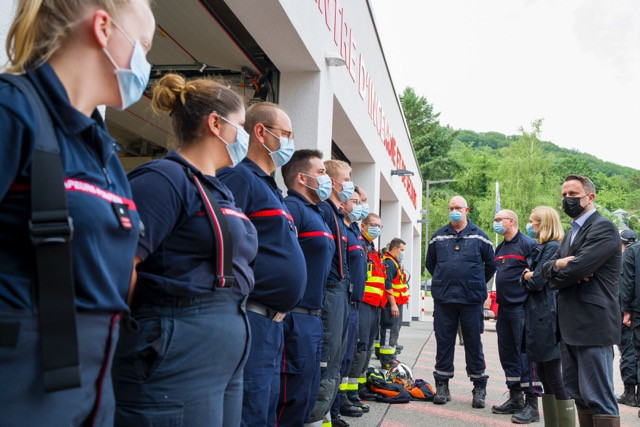Last Wednesday’s severe flooding took many by surprise. A period of sustained heavy rainfall had been predicted, but many of the tragic consequences when rivers across Luxembourg, Germany, Belgium and the Netherlands burst their banks could probably have been prevented.
Compared to the catastrophic loss of human life in Germany, the grand duchy escaped without anyone suffering serious injury. “A little over 550 people were evacuated, or rehoused,” Paul Schroeder, director of the emergency rescue service CGDIS said on RTL on Saturday. Although some people were reluctant to abandon their homes, nobody was forced to leave their residence against their will – a measure that is open to the authorities in a disaster situation, according to National Protection high commissioner Luc Feller.
But what else could people have done to receive information and perhaps get an early enough warning to take preventative measures? Feller explained on RTL that the , introduced in 2018 to provide instant information on fires, accident, severe weather, nuclear accidents and power outages, was overburdened. The app has only been downloaded to just 15,000 devices. Feller says that the app is being updated so that it can handle more traffic and also provide more targeted information.
Warnings were issued
But, writing for , Luxembourg PhD researcher in hydrometeorology Jeff Da Costa writes that “the unfolding catastrophe is a sad reminder of just how inadequate early warning systems can be.” He says that the European Flood Awareness System (EFAS) did actually issued a flood warning at the beginning of last week for the regions that ended up being so badly affected on Wednesday. “This information was passed to a variety of national authorities, which can differ depending on the member countries,” Da Costa writes. “But the bodies receiving this information were specific to each country. As a result, the responsibility of implementing any actions on the ground based on a flood warning is taken at a political level.”
He says that the difference between the way different countries acted was marked. The Dutch province of Limburg issued evacuation warnings on Wednesday afternoon in advance of the flooding. The German state of Rhineland-Palatinate, where at least 110 people lost their lives, on the other hand, only started evacuating people when it was too late. In Luxembourg it is CGDIS that receives the initial alert and is responsible for transmitting the message to relevant local authorities.

Prime minister Xavier Bettel (DP) and interior minister Taina Bofferding (LSAP) talk with CGDIS emergency staff on Thursday 15 July 2021 Matic Zorman
Jean-Paul Lickes, director of the water management authority, reckons Luxembourg’s response ran “like clockwork”. He told RTL on Saturday that compared to 120 or 15 years ago, the grand duchy has come a long way, both in terms of crisis management as well as in the predictive instruments it has at its disposal. Luc Feller agrees, saying that Luxembourg is now better informed and has better monitoring. “There are means being put in place in different administrations that will allows us be able to react even better.”
But blame for the extent of the flooding is also being put on increasing urbanization. Quite simply, the more you build, the scarcer is the land that is able to absorb flood waters or rising water tables.
Act upstream
Carole Dieschbourg (déi Gréng), minister of the environment, climate and sustainable development agrees that more needs to be done. “All new infrastructures and constructions are planned with properly dimensioned retention levels,” she told Paperjam. “But there are still old buildings that can be problematic. We have already implemented measures in some places with the help of the municipalities and it is working.” But that does not mean there is no need to continue investing to reduce the risk associated with floods. “We also need to raise awareness and act upstream, it costs less than repairing the damage.”
Just last month, the ministry launched the public consultation phase of the second edition of Luxembourg’s flood risk management plan. “In this plan, we introduced extreme events and were able to map, with different partners, places at risk. We have worked with the municipalities to identify what is and what is not going well. The purpose of the plan is to look at where we need more retention basins, renaturation, to give more space to river flow, to avoid risks especially in areas that are not even in direct contact with the water," Dieschbourg as she returned from the flood damaged town of Echternach.
Moreover, the water management authority, in collaboration with the Luxembourg Institute of Science and Technology (List), has updated maps on the geoportal site indicating the grand duchy’s flood zones. Being aware that one lives in an area at risk might also get citizens to put pressure on the municipalities to improve their readiness for extreme weather events and help avoid future tragedies.
But Da Costa, whose parents’ home was flooded out last week, argues that there needs to be a coordinated warning system in place for all affected areas, regardless of borders and local government. “The system is fundamentally flawed,” Da Costa says. “While the EFAS is highly effective in detecting threats, the different ways countries delegate responsibility for warning their citizens creates a gridlock along the chain of transmission. Ordinary people pay the price, sometimes with their lives.”
